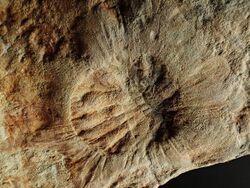Biology:Palaeophragmodictya
| Palaeophragmodictya | |
|---|---|

| |
| Fossil of P. spinosa | |
| Scientific classification | |
| Domain: | Eukaryota |
| Kingdom: | Animalia |
| Phylum: | Porifera |
| Class: | Hexactinellida |
| Order: | †Reticulosa |
| Genus: | †Palaeophragmodictya Gehling & Rigby, 1996 |
| Species | |
| |
Palaeophragmodictya is an extinct genus of sponge-grade organisms from the Ediacaran Period. Originally interpreted as a hexactinellid sponge,[1] the organism also bears some coelomate characteristics, including bilateral symmetry.[2][3]
Morphology
The organisms take the form of a rounded, dome-like bag, 7–68 mm in diameter, with an uneven margin. Radial grooves define sac-like compartments within the bag. The radial pattern has an element of bilateral symmetry. A stalk emerges from the central point of some specimens, at the top of the organism; in life, it probably extended into the water column. Ray-like filaments radiate outwards from the edge of the bag.[2] Some structures in the organism have been interpreted as spicules.[1][4]
Ecology
The organisms have been interpreted as tall suspension feeders, reaching 10 cm or more up into the sea water above them.[1][5]
Original description
The genus was originally considered to be a member of the Dictyospongiidae family (hexactinellia), and was among the first Precambrian sponges to be described.[1]
Distribution
First found in the Pound group of Australia, fossils have also been recovered from the White Sea region of Russia.[2]
Other Sponge-Grade Ediacarans
See also
References
- ↑ 1.0 1.1 1.2 1.3 Gehling, J. G.; Rigby, J. K. (1996), "Long expected sponges from the Neoproterozoic Ediacara fauna of South Australia", Journal of Paleontology 70 (2): 185–195, ISSN 0022-3360
- ↑ 2.0 2.1 2.2 Serezhnikova, E. (2007), "Palaeophragmodictya spinosa sp. Nov., a bilateral benthic organism from the Vendian of the Southeastern White Sea Region", Paleontological Journal 41 (4): 360–369, doi:10.1134/S0031030107040028, http://www.maik.ru/cgi-perl/search.pl?type=abstract, retrieved 2008-08-16
- ↑ Botting, J. P. (2007), ""Cambrian" demosponges in the Ordovician of Morocco: Insights into the early evolutionary history of …", Geobios 40 (6): 737–748, doi:10.1016/j.geobios.2007.02.006
- ↑ Ivantsov, A. Y.; Malakhovskaya, Y. E.; Serezhnikova, E. A. (2004), "Some Problematic Fossils from the Vendian of the Southeastern White Sea Region", Paleontological Journal 38 (1): 1–9, archived from the original on 2013-07-20, https://web.archive.org/web/20130720183943/http://www.vend.paleo.ru/pub/Ivantsov_et_al_2004_eng.pdf
- ↑ Yuan, X.; Xiao, S.; Parsley, R. L.; Zhou, C.; Chen, Z.; Hu, J. (2002), "Towering sponges in an Early Cambrian Lagerstätte: Disparity between nonbilaterian and bilaterian epifaunal tierers at the Neoproterozoic-Cambrian transition", Geology 30 (4): 363–366, doi:10.1130/0091-7613(2002)030<0363:TSIAEC>2.0.CO;2, ISSN 0091-7613, http://geology.geoscienceworld.org/cgi/content/abstract/30/4/363
Wikidata ☰ Q7126481 entry
 |

